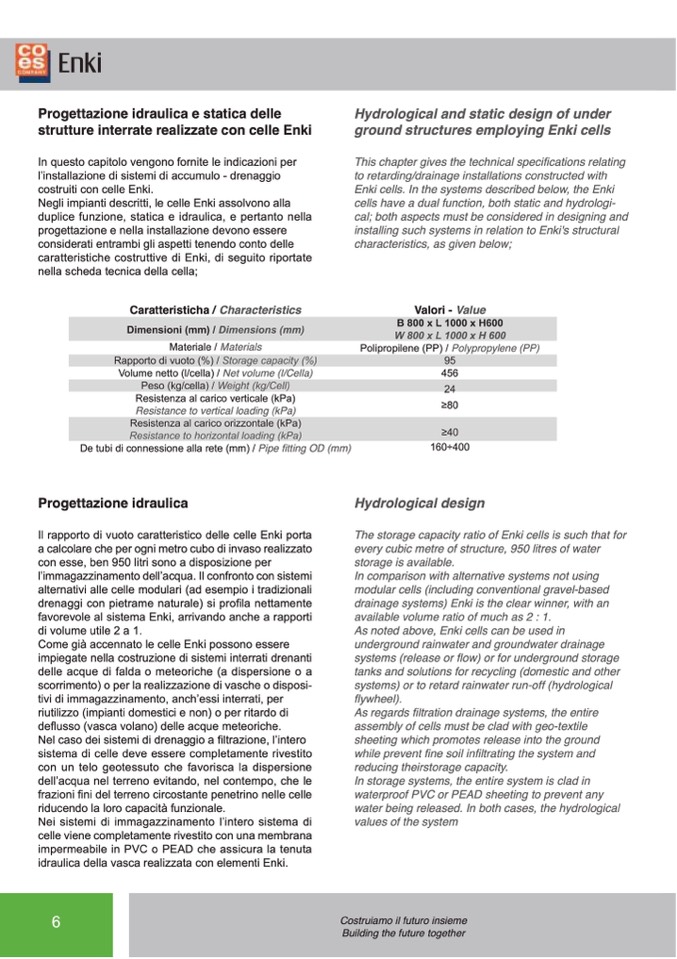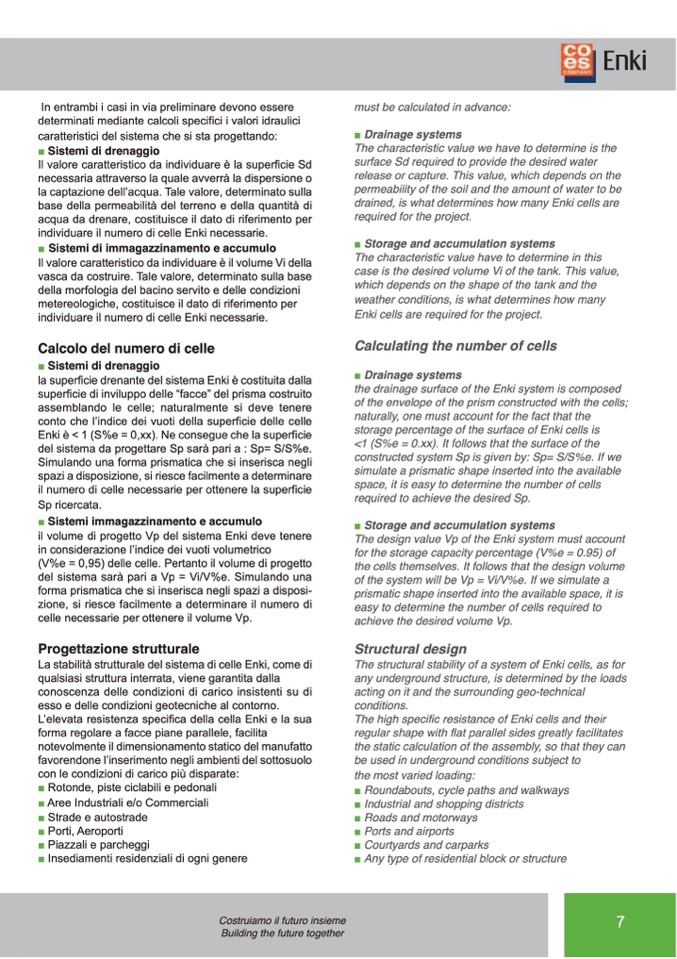


In entrambi i casi in via preliminare devono essere
determinati mediante calcoli specifici i valori idraulici
caratteristici del sistema che si sta progettando:
■ Sistemi di drenaggio
Il valore caratteristico da individuare è la superficie Sd
necessaria attraverso la quale avverrà la dispersione o
la captazione dell’acqua. Tale valore, determinato sulla
base della permeabilità del terreno e della quantità di
acqua da drenare, costituisce il dato di riferimento per
individuare il numero di celle Enki necessarie.
■ Sistemi di immagazzinamento e accumulo
Il valore caratteristico da individuare
è il volume Vi della
vasca da costruire. Tale valore, determinato sulla base
della morfologia del bacino servito e delle condizioni
metereologiche, costituisce il dato di riferimento per
individuare il numero di celle Enki necessarie.
Calcolo del numero di celle
■ Sistemi di drenaggio
la superficie drenante del sistema Enki è costituita dalla
superficie di inviluppo delle “facce” del prisma costruito
assemblando le celle; naturalmente si deve tenere
conto che l’indice dei vuoti della superficie delle celle
Enki è < 1 (S%e = 0,xx). Ne consegue che la superficie
del sistema da progettare Sp sarà pari a : Sp= S/S%e.
Simulando una forma prismatica che si inserisca negli
spazi a disposizione, si riesce facilmente a determinare
il numero di celle necessarie per ottenere la superficie
Sp ricercata.
■ Sistemi immagazzinamento e accumulo
il volume di progetto Vp del sistema Enki deve tenere
in considerazione l’indice dei vuoti volumetrico
(V%e = 0,95) delle celle. Pertanto il volume di progetto
del sistema sarà pari a Vp = Vi/V%e. Simulando una
forma prismatica che si inserisca negli spazi a disposi-
zione, si riesce facilmente a determinare il numero di
celle necessarie per ottenere il volume Vp.
Progettazione strutturale
La stabilità strutturale del sistema di celle Enki, come di
qualsiasi struttura interrata, viene garantita dalla
conoscenza delle condizioni di carico insistenti su di
esso e delle condizioni geotecniche al contorno.
L’elevata resistenza specifica della cella Enki e la sua
forma regolare a facce piane parallele, facilita
notevolmente il dimensionamento statico del manufatto
favorendone l’inserimento negli ambienti del sottosuolo
con le condizioni di carico più disparate:
■ Rotonde, piste ciclabili e pedonali
■ Aree Industriali e/o Commerciali
■ Strade e autostrade
■ Porti, Aeroporti
■ Piazzali e parcheggi
■ Insediamenti residenziali di ogni genere
must be calculated in advance:
■ Drainage systems
The characteristic value we have to determine is the
surface Sd required to provide the desired water
release or capture. This value, which depends on the
permeability of the soil and the amount of water to be
drained, is what determines how many Enki cells are
required for the project.
■ Storage and accumulation systems
The characteristic value have to determine in this
case is the desired volume Vi of the tank. This value,
which depends on the shape of the tank and the
weather conditions, is what determines how many
Enki cells are required for the project.
Calculating the number of cells
■ Drainage systems
the drainage surface of the Enki system is composed
of the envelope of the prism constructed with the cells;
naturally, one must account for the fact that the
storage percentage of the surface of Enki cells is
<1 (S%e = 0.xx). It follows that the surface of the
constructed system Sp is given by: Sp= S/S%e. If we
simulate a prismatic shape inserted into the available
space, it is easy to determine the number of cells
required to achieve the desired Sp.
■ Storage and accumulation systems
The design value Vp of the Enki system must account
for the storage capacity percentage (V%e = 0.95) of
the cells themselves. It follows that the design volume
of the system will be Vp = Vi/V%e. If we simulate a
prismatic shape inserted into the available space, it is
easy to determine the number of cells required to
achieve the desired volume Vp.
Structural design
The structural stability of a system of Enki cells, as for
any underground structure, is determined by the loads
acting on it and the surrounding geo-technical
conditions.
The high specific resistance of Enki cells and their
regular shape with flat parallel sides greatly facilitates
the static calculation of the assembly, so that they can
be used in underground conditions subject to
the most varied loading:
■ Roundabouts, cycle paths and walkways
■ Industrial and shopping districts
■ Roads and motorways
■ Ports and airports
■ Courtyards and carparks
■ Any type of residential block or structure
Costruiamo il futuro insieme
Building the future together



